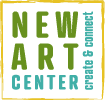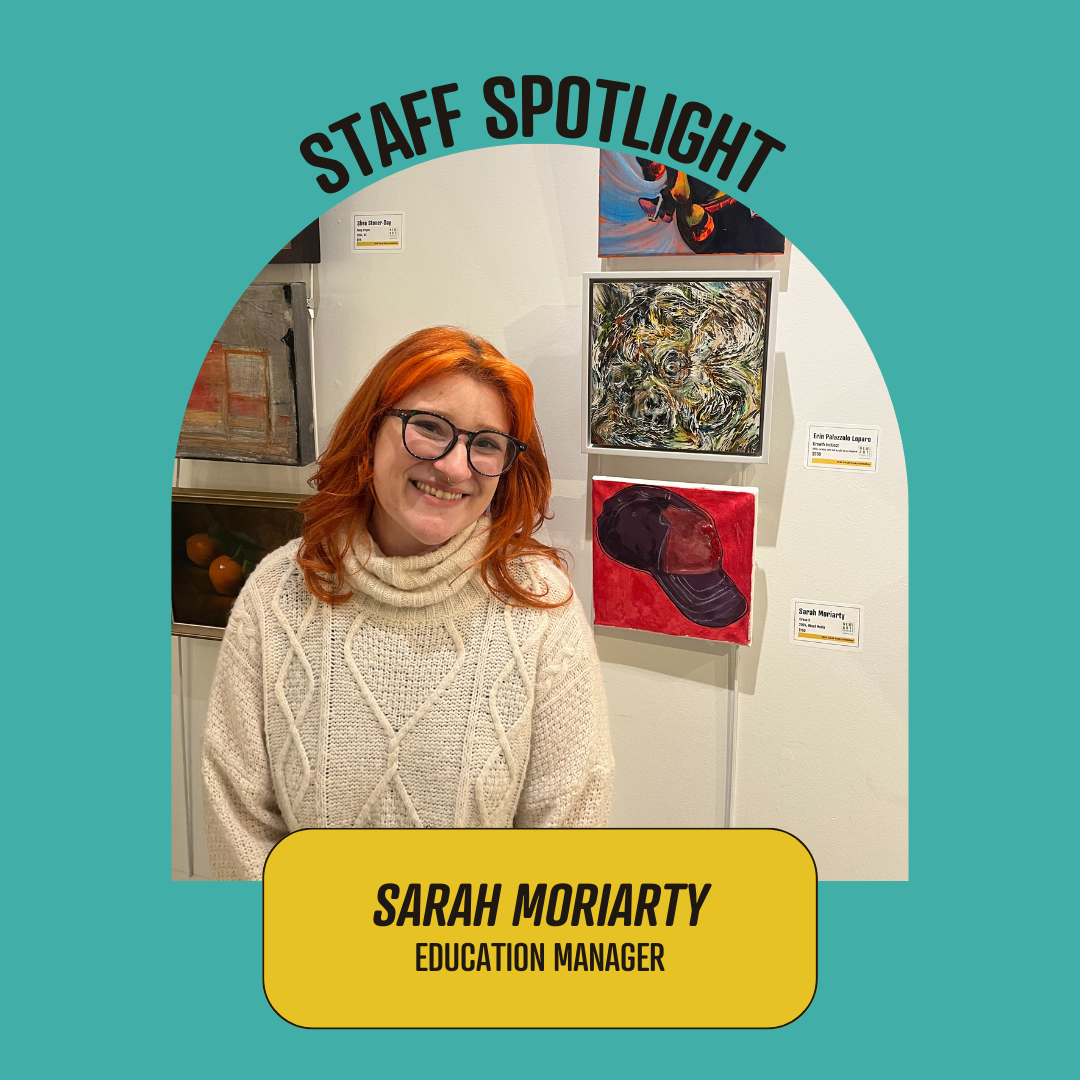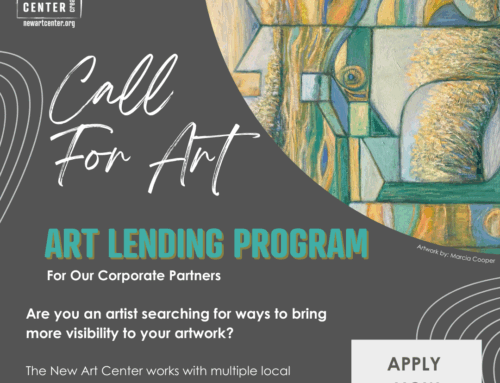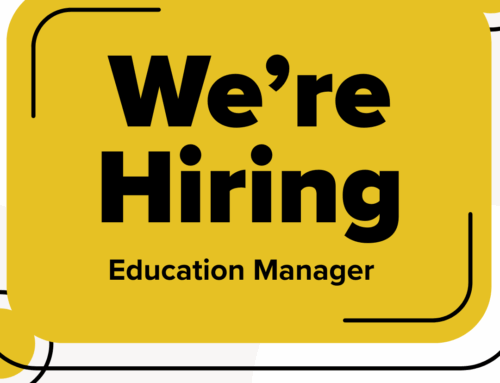The Picture above: Sarah with her artwork at the ‘Small Works’ Exhibition, New Art Corridor, Newton MA., December 2024.
1.Can you tell us about your journey as both a Program Manager and an artist? How do these two aspects of your life influence each other?
I first started working at the New Art Center in the summer of 2019. After only a few weeks as a TA, I knew this was the place for me. I had previously worked at several different camps of different sizes and settings, as well as a few Boston museums, but came to understand that New Art was unique for the enthusiasm with which teachers and students connected with each other through art.
After attending graduate school and moving back to the Boston area, I served as the Summer Coordinator in 2021, continued teaching at New Art part-time, and then joined the staff as the full-time Education Coordinator. I’ve had so many opportunities to grow as a young professional and build the New Art community, and have now stepped into the role of Education Manager as of August 2024.
As someone who studied Art History (BA) and Curation (MA), I never fully considered myself an ‘artist.’ But, in my time working with all of the amazing teaching artists at New Art, I’ve grown to understand that I don’t need to be formally trained or have a specialty to be an artist. I experiment with several different mediums, and I’m constantly inspired by those around me.
2. What is your vision for the New Art Center this year, especially in terms of programs you’re excited about or new initiatives you want to implement?
I’m approaching my sixth summer with New Art and I’m so excited to see new and familiar faces. Our Teen Summer Studios is now offering a certificate program, with opportunities for students to showcase their artwork at the end of the summer exhibition. We’re continuing to grow our art therapy offerings, and have some exciting potential partnerships that will only enhance these programs.
Right now, our team is working to understand what makes New Art Center unique, and what we can provide for our students, families, and communities that offer the most benefit for all. I’m excited to gain insight into why people come to New Art, and what they’re looking for. If you’d like to help us in this endeavor, please reach out to our staff.
3. What do you find most fulfilling about your role as a Program Manager at the art center?
From my experience of co-leading the Art as Therapy program with Erin Loparo, I have had the opportunity to see first-hand the effect that art can have on our students. Understanding the role that art can play in one’s life has pushed me even more to support our programs in any way possible. Being able to see students have impactful classroom experiences, with their own art, with their peers, and with their instructors, continues to inspire me to do what I do. I don’t think it will ever stop bringing me joy to hear that someone had a meaningful experience in one of our classes, programs, or camps.
Additionally, overseeing our Youth Leader high school interns has been a learning experience for us all! I’m so inspired by our Youth Leaders and their passion, curiosity, and creativity as they learn about arts administration careers and carry out their final projects.
P.S. My all-time favorite thing of all about working at New Art for as long as I have is seeing students return year after year. It’s so nice to watch our young students grow up and continue to develop their artistic skills while making memories within our programs. I just wish they would stop getting taller than me!
4. How do you see the role of arts programs in shaping or engaging the local community?
I strongly believe that art (and education) is, at its core, a conversation; whether that is from artist to viewer, teacher to student, or art center to community (and vice versa). Art presents itself as a universal language, that connects so many people and initiates relationships and exchanges that enhance our lived experiences. I think the New Art Center’s role is to provide resources, opportunities, and experiences that help our community connect with each other through making art, talking about art, and creating together.
5. Is there a quote or guiding philosophy that inspires both your creativity and your leadership in the arts?
Time and time again, I return to the manta “Practice makes progress, it doesn’t make perfect, because there is no such thing as perfect – especially in art!” A great visual representation of this is looking through a completed sketchbook – in the beginning, you see the trial and error, and the experiments. As you flip through, you can watch as skills develop, your artistic voice becomes clear, and the growth that happens incrementally over time. But with that, there will always be “off days” where your pencil just isn’t doing the thing you want it to do, or your creative spark is duller than usual; accepting that as part of the experience is so important. Learn to appreciate those off days, and always push to just make art, no matter how it looks.
6. Has your perspective as an artist changed since you started managing arts programs? If so, how?
Yes, absolutely! Before stepping into my current role, I wouldn’t have referred to myself as “an artist.” There was this mental block that told me I couldn’t be an artist if I hadn’t been formally trained, or sold work, or put meaning behind my pieces. Now, having seen such a wide range of students, artistic practices, teaching styles, and artwork, my concept of what constitutes “art” has evolved. Art doesn’t have to be perfect to be good; it doesn’t have to be shown to the world, or sold, to have value. Art is simply an outward, visual expression of one’s thoughts and/or feelings. For me, my artwork fulfills its purpose if it makes me feel better. That could mean that I make an artwork that I’m proud of, and want to exhibit publicly. Or it could mean that I made something that served as some sort of emotional release. I think a lot of this perspective shift can be attributed to being involved with our expressive arts programs.
7. Do you have any specific mediums or techniques that you’re particularly drawn to in your artwork?
Most often, I work with collage, oil pastels, acrylic, and fiber arts, including embroidery and knitting.
8. Who are some artists—whether historical, contemporary, or peers—that you find particularly inspiring?
My favorite artist from art history is Ana Mendieta. Early in her life, as a young Cuban immigrant who felt disconnected from American ideals, she was moved from refugee camps to foster homes, living at times in reform school. Because of the constant moves, Mendieta was not able to fully call a place home for long. Instead, she believed the closest thing she had to a home was the earth itself.
Mendieta’s early work from her undergraduate program focused on subverting the male gaze and playing with gender expression. Having studied both Art History and Gender Studies in my own undergraduate career, her work stands out to me as a feminist experiment to test the limits of the beauty standards imposed upon women. Her most well-known work, and the body of work I am most fascinated by, is her Silueta series. In a statement on her work, she said, “I am overwhelmed by the feeling of having been cast from the womb (nature). My art is the way I re-establish the bonds that unite me in the universe. It is a return to the maternal source.” Throughout her works, Mendieta presents themes and images of femininity, connection to the earthly realm, and displacement.
I think, from my appreciation of Ana Mendieta’s work and practice, I’m inclined to explore similar themes and imagery in my own work. I play with self-portraiture, place, and challenging expectations of visual representation.
As far as local artists go, all of the instructors we work with at New Art Center have been inspiring and wonderful to work with. Some artists of particular interest: Ola Aksan (@ola_aksan), Kylie Marden (@kyliemceramics), Meag Hepp (@meagan.hepp.art), Lexi Hall (@lexi.paints), Stephanie Li (@hemlockcreates), Jane Kim-Testa (@janekimtesta), and Kayla Falcone (@thefungussculpturelady).
We’ll be highlighting staff and faculty artists throughout the year. Sarah is the Education Manager at the New Art Center Sarah has been teaching at New Art Center since 2019 and stepped into the Education Coordinator role in 2022. After receiving her BA in History and Art History from Bridgewater State University, she went on to earn an MA in Culture, Criticism, and Curation from the University of Arts London. Sarah loves engaging with our younger students and fostering connections within our community.




